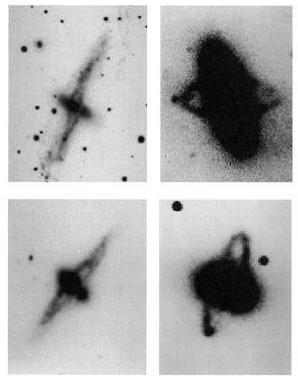

A polar-ring galaxy (PRG) consists of a flattened galaxy with an outer ring of gas, dust and stars rotating in a plane approximately perpendicular to the central disk. Kinematically confirmed PRGs with a disk-dominated central galaxy tend to have wide, extended polar rings, while bulge-dominated objects show short narrow rings (Reshetnikov, V.P. & Sotnikova, N., A&Ap, 325, 933, 1997; Whitmore, B.C., in Warped Disks and Inclined Rings around Galaxies, eds. Casertano, S., Sackett, P., & Briggs, F., CUP, 1991, pg. 60). The PRGs probably represent merger products, and their study may provide valuable clues about the process and frequency of merging; theirvisible environment appears to be similar to that of normal galaxies (Brocca, C., Bettoni, D, & Galletta, G., A&Ap, 326, 907, 1997), which may support long formation and evolution times of the rings. In addition, measurement of rotation in the two nearly perpendicular planes of the ring and the galaxy provide one of the few avaiable probes of the 3-dimensional galactic gravitational potential, and hence the shape of dark and luminous matter distributions.
Adapted from van Driel, W., Arnaboldi, M., Combes, F. & Sparke, L.S. A&Ap Suppl., 141, 385-408, 2000.
Early-type galaxies with polar ring structures are reviewed in Athanasoula, E., Bosma, A., ARAA, 23, 147, 1985 and Knapp, G.R. IAU Symposium No. 100: Internal Kinematics and Dynamics of Galaxies, 1983, p. 297, with a listing of known such systems appearing in Schweizer, F., Whitmore, B., Rubin, V.C. A.J., 88, 909, 1983; see also Schanberg, B.C. Ap.J. Suppl., 26, No. 230, 115, 1973. Examples can be found in the Arp-Madore Catalogue of Southern Peculiar Galaxies and Associations
Whitmore, B.C., Lucas, R.A., McElroy, D.B., et al., A.J., 100, 1489, 1990 provide an updated list of over 100 known PRGs, PRG candidates, and possibly related systems. They suggest four main categories:
The following is adapted from Bertin,G., Dynamics of Galaxies, 2000 (Cambridge University Press):
Indeed there is an interesting class of galaxies with prominent rings (the so-called polar-ring galaxies) for which we have a chance of additional dynamical constriants beyond those provided by the standard rotation curve associated with the motion of material in the disk. A general working hypothesis in many models of gaseous rings is that they are identified with closed orbits (for single particles) associated with the underlying potential. In reality, the dynamics of the observed ring is related to the settling of gas into such an orbit, which may involve some non-trivial collective processes. Thus the related problem of diagnostics, that is, the problem of reconstructing the underlying field from observed orbits, is generally marked by severe ambiguities. The astrophysical problem has an additional source of uncertainty, which is the fact that we generally have incomplete knowledge of the underlying orbit under consideration.